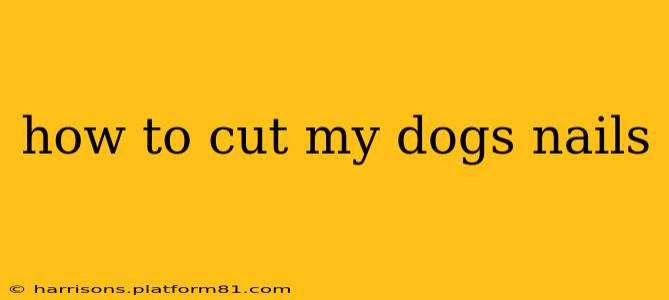Trimming your dog's nails might seem daunting, but with the right technique and tools, it can become a manageable and even enjoyable part of your dog's grooming routine. This guide provides a step-by-step approach, addressing common concerns and offering tips for a successful nail trim. Remember, patience and positive reinforcement are key!
What You'll Need:
Before you begin, gather these essential supplies:
- Appropriate nail clippers: Guillotine-style clippers or scissor-style clippers are both effective. Choose the type you're most comfortable using. Avoid human nail clippers, as they are not designed for the thickness of a dog's nails.
- Styptic powder or pencil: This is crucial for stopping any bleeding should you accidentally cut the quick (the pink part of the nail containing blood vessels and nerves).
- Treats: High-value treats are essential for positive reinforcement.
- Towel (optional): A towel can help restrain a wiggly dog.
Getting Started: Introducing Your Dog to Nail Trimming
Acclimating your dog to the process is crucial. Start by gently handling their paws and touching their nails a few days before the actual trim. Reward them with treats and praise for their calmness. This positive association will make the experience less stressful for both of you.
How to Cut Your Dog's Nails: A Step-by-Step Guide
- Find a comfortable position: Choose a well-lit area where you can comfortably hold your dog. Some dogs are more comfortable lying down, while others prefer to sit.
- One paw at a time: Focus on one paw at a time to avoid overwhelming your dog.
- Identify the quick: The quick is the pink part of the nail containing blood vessels and nerves. In light-colored nails, it's easy to see. In dark nails, it's more challenging, so it's best to trim only the very tips initially.
- Trim at an angle: Avoid cutting straight across; trim at a slight angle to prevent splitting. It's better to trim a small amount at a time, than to cut too much and risk hitting the quick.
- Use sharp clippers: Dull clippers can crush the nail, making it more likely to bleed and causing discomfort.
- Reward with treats and praise: Positive reinforcement throughout the process will keep your dog calm and cooperative.
What if I Cut the Quick?
Accidents happen. If you accidentally cut the quick, don't panic. Apply styptic powder or a styptic pencil directly to the bleeding nail. This will usually stop the bleeding quickly. If bleeding is profuse or doesn't stop, consult your veterinarian.
How Often Should I Trim My Dog's Nails?
The frequency of nail trims depends on your dog's breed, activity level, and the rate at which their nails grow. As a general rule, aim for trimming every 2-4 weeks or whenever you hear their nails clicking on the floor.
Different Nail Types and Trimming Considerations
- Dark nails: It's more difficult to see the quick in dark-colored nails. Trim small amounts at a time, and be extra cautious.
- Thick nails: Thick nails may require more powerful clippers. Consider using a grinder for thicker nails.
- Deformed nails: If your dog has deformed or overgrown nails, consult your veterinarian or a professional groomer for guidance.
Should I let a Professional Groomer Trim My Dog's Nails?
If you're uncomfortable trimming your dog's nails yourself, a professional groomer can provide this service. Many groomers are skilled in handling dogs of all temperaments and sizes.
My Dog Hates Getting Their Nails Trimmed!
If your dog is resistant, try desensitization techniques. Start by handling their paws regularly, rewarding them with treats and praise. Gradually introduce the clippers, letting them sniff and investigate before making any contact with their nails. Consider working with a professional trainer or groomer if needed.
This guide provides a starting point for successfully trimming your dog's nails. Remember, patience, positive reinforcement, and a calm approach are key to a positive experience for both you and your canine companion. If you remain unsure or concerned, consulting a veterinarian or professional groomer is always recommended.
